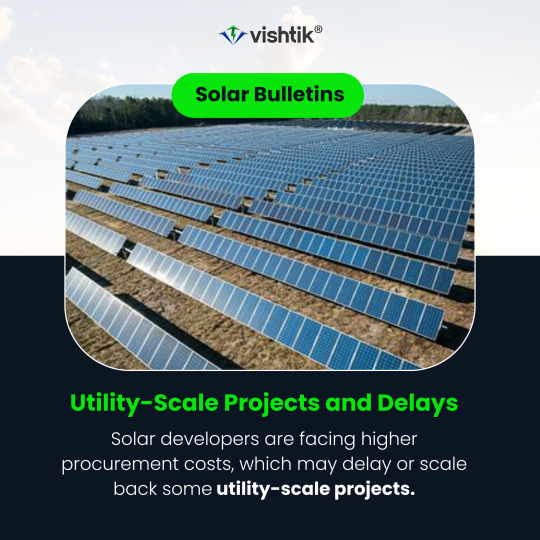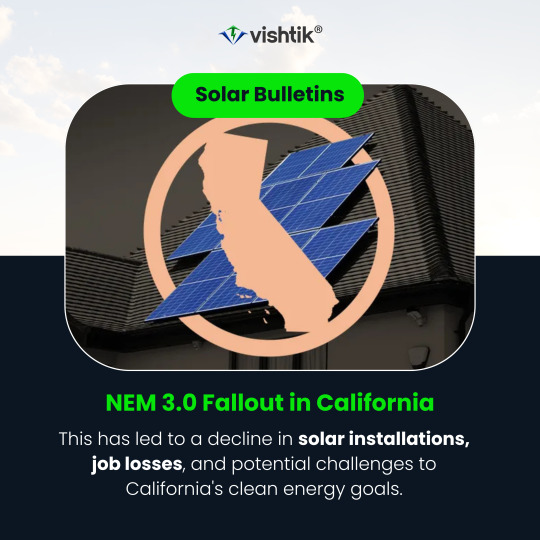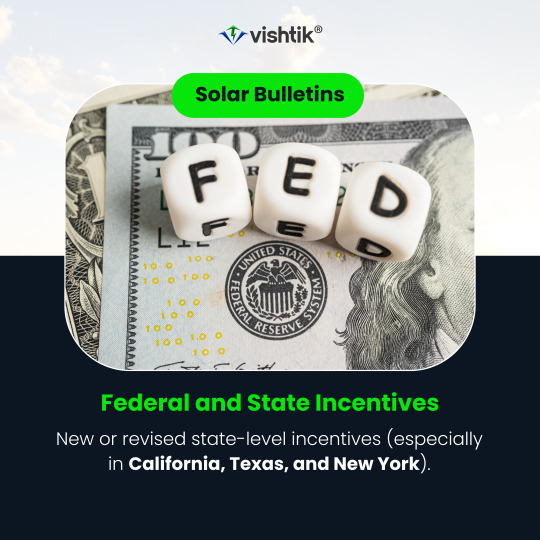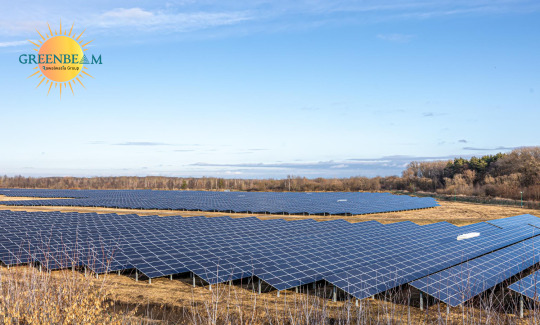#UtilityScaleSolar
Explore tagged Tumblr posts
Text
Solar Panel Farms 😮😆
#desiviralrecap#SolarEnergy ☀#SolarPower ⚡#RenewableEnergy#CleanEnergy#GoSolar#GreenEnergy#SolarPanels#SustainableLiving#SolarFarms#SolarFarmLife#SolarPark#SolarProjects#SolarGrid#UtilityScaleSolar#SolarInnovation#SolarSolutions#EcoFriendly#ClimateAction#FutureIsSolar#SolarRevolution#EnergyEfficiency#SolarTechnology#GreenTech#NetZero
1 note
·
View note
Text
Solar PV Inverters Market Drivers Push Equipment Demand Amid Infrastructure Boom Worldwide
As global infrastructure initiatives gain momentum, the Solar PV Inverters Market Trends are seeing significant uplift due to powerful market drivers. These catalysts are transforming how solar inverters are designed, integrated, and deployed across energy projects. From utility-scale solar plants to rooftop systems, increased demand for efficient, reliable, and grid-supportive inverters is being observed across both developed and emerging economies.

Infrastructure Boom: The Primary Catalyst
Worldwide, countries are making large-scale investments in infrastructure, particularly in clean energy. Nations like India, China, the United States, and several European Union members are driving major renewable energy projects to meet climate targets. This construction surge has directly influenced the demand for solar PV inverters as they are essential in converting DC power from solar panels into usable AC power for the grid. Governments are emphasizing decarbonization through solar energy, further propelling demand.
Additionally, the rollout of national electrification programs in Africa and Southeast Asia is expanding off-grid and microgrid applications. These setups rely heavily on string and central inverters, contributing to a healthy global demand.
Decentralization and the Rise of Rooftop Installations
Residential and commercial buildings are increasingly adopting rooftop solar solutions. As more prosumers seek energy independence and cost savings, there's a push for decentralized energy models. This shift supports the growth of single-phase and three-phase inverters suited for distributed energy systems. These compact and efficient inverters also offer greater flexibility for integration with battery energy storage systems (BESS).
In developed markets, policies like net metering and tax credits have further incentivized residential and small business owners to invest in solar, increasing the demand for high-efficiency inverters with smart features and grid support capabilities.
Grid Modernization and Smart Inverter Technologies
One of the strongest drivers reshaping the market is the global trend toward grid modernization. Smart grids need smart inverters—devices capable of voltage regulation, frequency control, reactive power compensation, and communication with the grid. These features not only stabilize the grid but also enable renewable penetration to rise without jeopardizing reliability.
Grid-forming inverters are becoming particularly vital in renewable-dominated energy systems. The push for inverters with advanced functionalities stems from their ability to offer grid support, helping utilities transition from traditional synchronous generation to inverter-based resources.
Demand for Energy Resilience and Storage Integration
Natural disasters, power outages, and rising energy prices are prompting industries and governments to improve grid resilience. Solar PV systems integrated with energy storage solutions are now considered essential infrastructure in regions prone to weather disruptions. Inverters that can seamlessly interact with batteries, manage peak loads, and operate during grid failures (islanding mode) are gaining traction.
This trend is especially visible in regions like California and Australia, where frequent blackouts and grid instability have encouraged users to adopt hybrid inverters with robust backup and storage capabilities.
Industrial Growth and Utility-Scale Solar Expansion
Large-scale solar farms are multiplying across sun-rich regions. Utility companies are deploying central inverters with higher wattage capacity to meet megawatt-scale energy production. These industrial-grade inverters offer better thermal management, lower total harmonic distortion, and enhanced MPPT (Maximum Power Point Tracking), ensuring higher yield and longer life cycles.
The growing popularity of solar farms across deserts, abandoned lands, and agricultural settings has stimulated demand for rugged, weather-resistant inverter systems capable of functioning in harsh conditions.
Government Incentives and Green Financing
Policies that provide financial incentives for solar projects—such as feed-in tariffs (FiTs), investment tax credits (ITCs), and accelerated depreciation—continue to drive inverter demand. Green financing options and public-private partnerships are making it easier for residential, commercial, and industrial consumers to access solar energy systems.
Multilateral institutions like the World Bank and the Asian Development Bank are also funding renewable energy initiatives in Africa, Asia-Pacific, and Latin America. These efforts invariably increase the deployment of solar inverters, especially in remote and underserved areas.
Technological Innovation Fuels Further Demand
The Solar PV Inverters Market is experiencing robust innovation. Manufacturers are developing smaller, more efficient inverters with AI-based monitoring, real-time diagnostics, and remote firmware updates. Features such as predictive maintenance and cloud-based analytics are improving reliability and performance, making inverters more appealing to end-users and utility operators alike.
These innovations not only improve user experience but also reduce operational costs over the inverter’s lifetime—an increasingly attractive prospect in cost-sensitive markets.
Conclusion
The solar energy landscape is evolving rapidly, driven by policy support, technological innovation, and infrastructure growth. As the backbone of solar energy systems, inverters are central to this transformation. Their expanding roles—ranging from basic power conversion to advanced grid stabilization—are being recognized across the energy value chain.
The next article will delve into how automation is reshaping construction projects and what it means for the Solar PV Inverters Market Trends, offering a closer look at the role of inverters in supporting digital and autonomous solar deployment strategies.
#SolarPVInverters#CleanEnergy#GridModernization#SmartInverters#RenewableEnergy#InverterTechnology#SolarPower#GreenInfrastructure#EnergyTransition#UtilityScaleSolar
0 notes
Text




For more updates, follow us!
Sign Up Now: http://project.vishtik.com Call us: +1 (307) 800-0424
#SolarNews#CleanEnergy#SolarPower#CaliforniaSolar#NEM30#SolarIncentives#GreenEnergy#SolarUpdates#RenewableEnergy#UtilityScaleSolar#SolarPolicy#EnergyTransition#SustainableFuture#SolarIndustry
0 notes
Text
Ground Mounted Solar: Powering the Next Phase of Renewable Growth

Ground Mounted Solar: Powering the Next Phase of Renewable Growth
As the world accelerates its transition toward renewable energy, ground mounted solar systems have emerged as a critical player in the clean energy revolution. According to IndustryARC, the global ground mounted solar market is expected to grow from strength to strength, reaching $9.65 billion by 2027 at a CAGR of 9.56% during 2022–2027. This momentum reflects both technological evolution and increasing demand for reliable, large-scale solar solutions.
What is Ground Mounted Solar?
Unlike rooftop systems, ground mounted solar panels are installed directly on the ground — making them ideal for open areas such as industrial fields, utility-scale solar farms, and large commercial properties. These systems can be fixed tilt or integrated with solar trackers to follow the sun’s movement, thereby optimizing energy output throughout the day.
Ground-mounted panels often resemble pole-mounted panels, but with the added advantage of direct ground placement, which simplifies infrastructure and lowers mounting costs in suitable terrains.
What’s Driving the Market?
Several key factors are fueling the rapid growth of this market:
✅ Rising Demand for Clean Electricity As governments and industries worldwide aim for net-zero carbon goals, solar energy continues to gain traction. Ground mounted systems are particularly favored for utility-scale power generation, thanks to their scalability and efficiency.
✅ Technological Advancements Modern ground mounted systems now incorporate single-axis and dual-axis trackers, increasing solar panel efficiency by 10% to 30%. This performance boost is especially valuable in high-insolation regions, helping to reduce the Levelized Cost of Energy (LCOE).
✅ Material Innovation The use of crystalline silicon (both monocrystalline and polycrystalline) is on the rise due to its high conversion rates and affordability. Coupled with metal frames like aluminum and galvanized steel, these materials enhance durability and energy capture — crucial for long-term ROI.
✅ Commercial and Industrial Adoption Beyond utilities, demand from commercial sectors such as hospitals, schools, retail centers, and warehouses is surging. With increasing focus on sustainability and operational cost reduction, businesses are investing in solar to secure energy independence and ESG compliance.
Market Segmentation Snapshot
Panel Material:
Crystalline Silicon (Monocrystalline, Polycrystalline)
Metal Frame (Aluminum, Galvanized Steel)
Glass Sheet
Tracking System:
Single-Axis Tracker
Dual-Axis Tracker
Power Rating:
<2 Megawatts
2–4 Megawatts
4 Megawatts
End-User:
Residential
Commercial
Industrial
Utility
The Road Ahead
As the world increasingly embraces sustainable energy, ground mounted solar is playing a pivotal role in shaping the renewable energy landscape. Its scalability, improved efficiency, and declining installation costs make it an ideal solution for high-demand sectors seeking reliable, green energy alternatives.
With continuous advancements in panel materials, solar tracking technologies, and policy support, this segment is poised for significant expansion. Businesses and governments that invest today will not only benefit from long-term savings but also contribute meaningfully to a cleaner, more resilient energy future.
Let’s keep moving forward — powered by the sun. ☀️
Source: https://www.industryarc.com/Report/19371/ground-mounted-solar-market.html
#GroundMountedSolar #SolarEnergy #Renewables #CleanEnergy #GreenTechnology #UtilityScaleSolar #Sustainability #EnergyTransition #SolarPower #ClimateAction #NetZero
0 notes
Text
Industrial Central PV Inverter Market to Grow to $9.8 Billion by 2033, Reflecting a 7.8% CAGR.
Industrial Central PV Inverter Market : Industrial central PV inverters are critical components in utility-scale solar power plants, converting the direct current (DC) generated by solar panels into usable alternating current (AC). These inverters are designed to handle high power outputs, ensuring efficient energy conversion for large installations. Known for their reliability and scalability, central inverters reduce system complexity by centralizing power conversion, making them a preferred choice for massive solar farms. With advancements in grid integration features and digital monitoring, modern central PV inverters are enhancing energy efficiency and enabling smarter, more resilient solar power systems.
To Request Sample Report : https://www.globalinsightservices.com/request-sample/?id=GIS31516 &utm_source=SnehaPatil&utm_medium=Article
In recent years, the integration of advanced cooling systems and durable materials has extended the lifespan of central PV inverters, reducing maintenance costs and boosting overall plant productivity. Innovations like multi-MPPT (Maximum Power Point Tracking) technology further optimize energy yield by adjusting to varying solar irradiation levels. As the demand for clean, renewable energy grows, industrial central PV inverters will continue to play a pivotal role in scaling solar power adoption and meeting global energy transition goals.
#CentralPVInverter #SolarEnergy #RenewablePower #UtilityScaleSolar #SolarInverterTech #GreenEnergySolutions #EnergyEfficiency #GridIntegration #CleanEnergy #SolarFarms #FutureOfSolar #SustainableTechnology #EnergyInnovation #RenewableEnergyTransition #SmartEnergySystems
0 notes
Text
Utility Solar Tracker 🌞: $3.2B to $7.8B by 2033, 9% CAGR
Utility Single Axis Solar Tracker Market : Utility single-axis solar trackers are transforming the efficiency of solar power plants by enabling solar panels to follow the sun’s path throughout the day. Unlike fixed solar systems, these advanced trackers tilt panels on a single axis, maximizing exposure to sunlight and increasing energy yield by up to 25–30%. Designed for utility-scale installations, single-axis solar trackers make solar plants more productive, ensuring greater returns on investment and enhancing the reliability of solar as a sustainable energy source. Their robust construction withstands varying weather conditions, making them ideal for large solar farms across diverse landscapes.
To Request Sample Report : https://www.globalinsightservices.com/request-sample/?id=GIS32546&utm_source=SnehaPatil&utm_medium=Article
As the demand for clean energy accelerates, utility single-axis solar trackers are a key technology driving the growth of solar power. By optimizing land use and reducing the levelized cost of energy (LCOE), these trackers are helping to make solar energy more accessible and economically viable. With advancements in automation and durability, single-axis trackers are becoming a standard in the solar industry, supporting ambitious renewable energy targets and contributing to a low-carbon future. This game-changing technology is empowering solar plants to produce more energy with less, bringing us closer to a sustainable energy revolution.
#SingleAxisSolarTracker #SolarInnovation #UtilityScaleSolar #RenewableEnergy #SolarEfficiency #CleanPower #GreenEnergy #SolarTracking #SustainableFuture #EnergyRevolution #SolarTechnology #MaximizeSunlight #LowerLCOE #SolarPowerPlants #FutureOfSolar
0 notes
Photo

India is leading the pack. 👏👏👏 . The Top 10 Solar PV Engineering, Production, and Construction (EPC) Companies in 2020. Read more about this topic on our website www.SolarEdition.com (link in bio) ----------***---------- Source:@ PV-Magazine, @AdaniSolar & @Solar_Edition Photo: @ PV-Magazine & @Solar_Edition …………… ‘All rights to go to the author of the news & image as mentioned above’ ----------------------- #adanisolar #adanigroup #solarmanufacturer #solarmarket #PVmodule #solarmodule #solarindustry #solarmodules #solarmanufacturers #firstsolar #JinkoSolar #TrinaSolar #LONGiSolar #solarpanel #commercialsolar #Utilityscale #utilityscalesolar #powerplant #solarelectricity #solarinstallation #solarpowered #solarpower #greenenergy #photovoltaic #cleanenergytech https://www.instagram.com/p/CFDgYe6HtjM/?igshid=1epjh5af2315j
#adanisolar#adanigroup#solarmanufacturer#solarmarket#pvmodule#solarmodule#solarindustry#solarmodules#solarmanufacturers#firstsolar#jinkosolar#trinasolar#longisolar#solarpanel#commercialsolar#utilityscale#utilityscalesolar#powerplant#solarelectricity#solarinstallation#solarpowered#solarpower#greenenergy#photovoltaic#cleanenergytech
0 notes
Link
Mahindra Susten provides all the resources they need to build bankable projects in utility scale solar business and also ensures that customers get the maximum benefits of it.
0 notes
Text
Utility-Scale 21 MWp Solar Power Plant by Sterling and Wilson Solar in Oregon, USA

Area of the plant - 75 acres Duration - 120 days (per project) Homes powered - 10,500 Number of panels - 75,000 Number of projects - 7 Explore Here - https://bit.ly/2XwaQpq #sterlingandwilson #sterlingandwilsonsolar #SWSL #SWSolar #solar #solarepc #epc #utilityscalesolar #solarplant #solarcontractor #SolarPower #solarenergy #solarsystem #solarpanel #solarproject
0 notes
Photo

REC Solar | Commercial Solar Solutions
REC Solar is a nationwide leader offering complete commercial and utility-scale solar solutions for California, Hawaii, and the West Coast. We provide a wide range of solar solutions including design, installation, financing, consulting, energy storage and more. We are a proven energy partner with 20-years of experience and 220+ megawatts of successful projects.
REC Solar is majority-owned by Duke Energy, giving our customers access to financing and expanded energy services like offsite solar and battery storage. Our goal is to maximize the value of our customers’ solar investments over time.
REC Solar
3450 Broad St #105 San Luis Obispo, CA 93401
(844) 732-7652
Social Profiles:
Facebook
Twitter
Linkedin
0 notes
Text
Utility Single Axis Solar Tracker Market to Expand to $7.8 Billion by 2033, Reflecting a 9% CAGR.
Utility Single Axis Solar Tracker Market :Utility Single Axis Solar Trackers (SAST) have revolutionized solar energy generation by optimizing photovoltaic (PV) panel alignment with the sun’s movement. Unlike fixed systems, these trackers dynamically adjust the panel’s tilt, significantly enhancing energy output by up to 25–35%. Their robust design, lower maintenance needs, and cost-effectiveness make them a preferred choice for large-scale solar farms globally. With renewable energy targets soaring, governments and private entities are increasingly adopting SAST systems to boost efficiency and maximize land utilization, paving the way for more sustainable energy solutions.
To Request Sample Report : https://www.globalinsightservices.com/request-sample/?id=GIS32546 &utm_source=SnehaPatil&utm_medium=Article
The integration of advanced technologies, such as machine learning and IoT in SAST, has further enhanced performance through real-time adjustments and predictive analytics. This innovation minimizes downtime, improves energy yield, and reduces operational costs. As the world races toward achieving net-zero emissions, utility-scale solar projects featuring SAST are becoming a cornerstone of green energy infrastructure. The surge in demand also highlights the growing role of solar trackers in energy transition strategies, underlining their significance in shaping a cleaner and brighter future.
#SolarTracker #RenewableEnergy #UtilityScaleSolar #SolarPower #CleanEnergyFuture #SolarTech #NetZero #EnergyEfficiency #SustainableEnergy #GreenTechnology #SolarFarms #ClimateSolutions #IoTInEnergy #SolarRevolution #FutureEnergy
0 notes
Text
Utility Solar EPC ☀️: $7.5B to $18.2B by 2033, 9.5% CAGR
Utility Solar EPC Market : Utility Solar EPC (Engineering, Procurement, and Construction) services are at the forefront of the solar revolution, bringing large-scale solar power plants to life with precision, efficiency, and sustainability. These EPC providers handle every stage of solar project development, from site assessment and engineering design to equipment procurement and construction management. With experienced teams and cutting-edge technologies, Utility Solar EPC services optimize solar plant performance, ensuring maximum energy output and long-term operational reliability. This seamless approach to solar project execution is essential as nations look to scale up renewable energy production and reduce their carbon footprints.
To Request Sample Report : https://www.globalinsightservices.com/request-sample/?id=GIS32547&utm_source=SnehaPatil&utm_medium=Article
As the demand for clean energy grows, Utility Solar EPC services are crucial for building resilient and scalable solar infrastructure. These companies are constantly innovating to streamline project timelines, reduce costs, and integrate new advancements in photovoltaic technology. With a focus on quality and environmental stewardship, Utility Solar EPC services play a pivotal role in meeting ambitious renewable energy goals worldwide. By accelerating the deployment of utility-scale solar power, they’re helping pave the way for a greener, more sustainable future.
#UtilitySolarEPC #SolarEnergy #RenewablePower #GreenInfrastructure #CleanEnergyRevolution #Photovoltaics #SolarPlantConstruction #SustainableEnergy #EPCEngineering #SolarFuture #CarbonReduction #SolarInnovation #EnergyTransition #ClimateAction #UtilityScaleSolar
0 notes
Text
Effect of Solar on Climate Change

The use of solar power is on the rise as countries around the world look for ways to reduce their carbon footprint and fight climate change. One country that has made significant strides in this area is India, where a number of large-scale solar power projects have been implemented in recent years.
The government of India has set an ambitious target of achieving 175 GW of renewable energy by 2022, which includes 100 GW of solar power. To achieve this goal, the government has launched several initiatives, such as the Jawaharlal Nehru National Solar Mission and the Kisan Urja Suraksha evam Utthan Mahabhiyan, to promote the development of utility scale solar projects.
The efforts have been paying off as India's solar capacity has grown from just 2 GW in 2014 to over 37 GW in 2020, and more than 100 GW is expected by the end of 2022. This expansion of solar energy is expected to make a significant impact on the country's carbon emissions. According to the Ministry of New and Renewable Energy, the 100 GW of solar power will displace an estimated 100 million tonnes of CO2 emissions per year.
One of the key advantages of solar power is that it is a clean and renewable source of energy. Unlike fossil fuels, it does not emit any greenhouse gases, which contribute to climate change. In addition to reducing emissions, solar power also helps to reduce air pollution, which is a major public health concern in many parts of India.
The growth of solar power in India has also led to the creation of jobs in the renewable energy sector. According to the National Solar Energy Federation of India, the country's solar power sector is expected to create around 8,00,000 jobs by 2022. This not only helps to promote economic growth but also helps to promote energy security, as India will not have to rely as heavily on imported fossil fuels.
It's worth noting that, while large-scale solar projects are a crucial step in the right direction, they are not the only solution to combat climate change. It's important to also consider distributed solar power, which refers to smaller solar power systems that are installed on individual homes or businesses. These systems not only help to reduce emissions but also promote energy independence for individuals and communities.
In conclusion, the growth of solar power in India is a positive step towards fighting climate change. Large-scale solar projects such as utility scale solar, not only help to reduce emissions and promote energy security, but also create jobs and promote economic growth. However, it is important that alongside the development of large scale solar power, distributed solar power should be also encouraged. With these efforts in place, India could play a leading role in the global fight against climate change.
0 notes
Link
Mahindra Susten ensures their clients get a bankable project by undertaking complete EPC projects under their utility scale solar business. They take care of everything, from site surveys to maintenance.
0 notes
Photo

Business Info India@Mangesh95459869·1m168 MWp #solarplant Turnkey EPC with 110 KV SS & LILO Interconnection on 198 hectares, in 10 months by using 4,50000 #solarpanels and powered 90,000 homes in #Vietnam by Sterling & Wilson Solar. Explore - https://bit.ly/3oc2kXE #Sterlingandwilsonsolar #solar #utilityscalesolar
0 notes